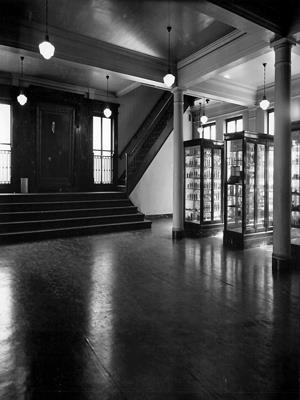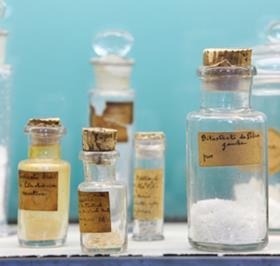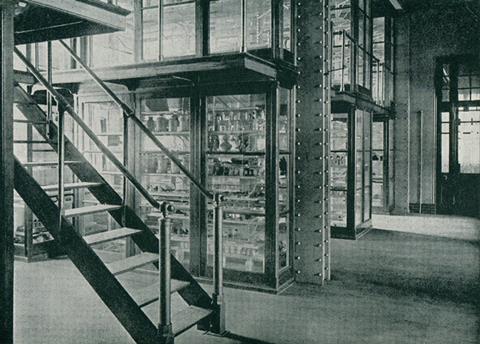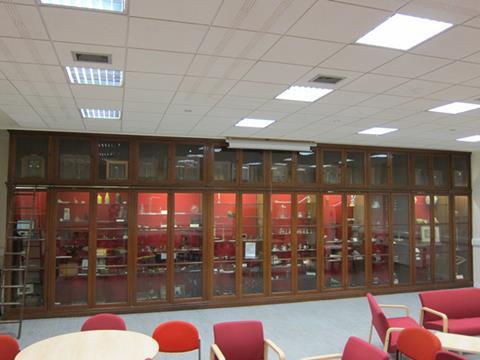Now forgotten but for a few dusty displays in foyers, chemical museums were once important teaching facilities in chemistry departments across the world, as Peter Morris discovers

In his annual report for 1909, the president of the Massachusetts Institute of Technology (MIT) wrote of the ‘real need’ for a chemical museum.1 A modern reader might be puzzled he wanted a chemical museum rather than a scientific facility such as an observatory or a laboratory to study a new field such as radioactivity or biochemistry. Why a museum, and why a chemical museum rather a more general science museum?
To understand his call, we must put aside our modern concept of a science museum being an institution for the promotion of science, geared towards young people and involving a good deal of interactivity. A chemical museum of the kind desired by MIT was intended purely for teaching purposes and would not have been open to the public. However, chemistry departments showed them off to eminent visitors such as the Meiji Emperor of Japan, who visited the newly opened chemical museum at the College of Engineering at the Imperial University, Tokyo (now the University of Tokyo), in 1896.
The purpose of the museum was to aid the teaching of chemical subjects which could not be easily studied through standard lectures or practical exercises. So they contained apparatus, specimens of chemicals (especially industrial chemicals), and models and diagrams of molecules, crystals and factories. William Crookes – a British chemist who invented the eponymous radiometer – described how a chemical museum should be organised in 1860. ‘But the specimens in a chemical museum be so ordered and labelled as to illustrate the types, the notation and the nomenclature of the science; while models of crystals and apparatus, together with diagrams and drawings, will serve to illustrate crystallography, chemical processes and the arts dependent thereon, as well as to familiarize the student with chemical symbols, formulae and reactions.’2
Pure vs applied
In some universities, they were regarded as collections of lecturing aids which were usually stored in a cupboard or the basement rather than museums. The use of the term ‘museum’ for these collections stemmed from a characteristically 19th century understanding of a museum being a collection used for research or learning, effectively the object equivalent of an archive or library, without any implication of public access. Hence these chemical museums were similar to the museums of natural history or mineralogy that still exist today, but lacked their focus on the taxonomical classification of specimens.

It appears that early chemical museums between the 1830s and 1870s were often used for collections of chemicals prepared in the laboratory, thus functioning as a reference collection which could be used to check the identity of substances. By the 1880s and 1890s, however, chemical museums had become specifically associated with applied chemistry and some were even called museums of applied chemistry. This use of the chemical museum has to be seen in the context of academic chemistry’s attempts to gain hegemony over the economically important and wealthy field of industrial chemistry. The ‘pure’ academic chemists had to wrest intellectual control of this field from the empirically trained industrialists and artisans on the one hand and academically trained engineers on the other hand.
At the same time, they had to be careful that it did not become a separate academic discipline. This was achieved by calling it ‘applied chemistry’ rather than industrial chemistry or the chemical arts. It was included in the general curriculum partly to persuade would-be industrial chemists to take chemistry degrees and partly to show that a knowledge of pure chemistry was necessary to understand industrial processes.
But how was this applied chemistry to be taught? Industrial processes did not lend themselves to practical work in an academic laboratory and the scale of the industry’s operations meant that they could not be reproduced in the lecture hall. Instead, chemistry lecturers showed specimens of the industry’s intermediate and final products, as well as models (and diagrams) of its equipment (such as the lead chamber and the black ash revolver) and factories. These items were natural candidates for inclusion in chemical museums and this trend was encouraged by donations of samples by chemical companies, who wished to bring themselves to the attention of prospective employees. When the University of Wisconsin set up a museum in 1901, for example, 12 companies gave industrial specimens and seven more firms were expected to make similar donations.
In the beginning
It is not clear when the first chemical museum was established. A strong case can be made for Ireland’s Trinity College Dublin, which erected an anatomical theatre and laboratory for the teaching of medicine and chemistry in August 1711. There was a museum on the upper floor which was probably a general museum with an emphasis on anatomy. In 1732, William Maple supplied glass frames for the display of insects and glass jars for reptiles which were presumably intended for this upper floor museum. However, three years earlier he had supplied a floorcloth for the little museum in the laboratory, which may have been a chemical museum.

When Torbern Bergman became the professor of chemistry at the University of Uppsala, Sweden, in 1767, the chemical laboratory had been gutted by a fire a year earlier. When he restored the laboratory, he converted the auditorium into a display area for a mineral collection owned by the university, but also displayed industrial models and specimens of industrial chemical intermediates in two side rooms. ‘My purpose here was also to get the ovens and tools in models of those crafts which more or less depend on chemistry,’ Bergman wrote. ‘Such crafts as the manufacture of glass, porcelain, glazed earthenware, pottery vessels, brick, tobacco pipes, all kind of salts, oils, gunpowder, lampblack, all fire-resistant dyes, but of which hitherto no collection has been made.’3
He got the idea of displaying this material from seeing a collection of industrial models and samples in the nearby Theatrum oeconomicum mechanicum assembled by the professor of economics, Anders Berch.
Trinity College unambiguously set up a chemical museum when it acquired a glass case in 1803 to house the teaching collection of the retiring chemistry professor Robert Perceval. Wilhelm August Lampadius, a mineralogical chemist and a supporter of Lavoisier’s theories, set up a chemical museum for the mining academy at Freiberg in Saxony (now Germany) in 1815 and a museum was established at the University of Prague (then part of the Austrian Empire, now Czech Republic) five years later. When chemistry at the University of Edinburgh, UK, moved into the new college buildings in 1823, there were two chemical museums, both in the higher levels of the building. The museum was moved to the new buildings at Teviot Place in 1888 and placed near the chemistry classroom.
Between the 1840s and 1860s, chemical laboratory buildings were built on a much grander scale than hitherto. These ‘chemical palaces’ (as Crookes called them) contained laboratories, lecture halls, libraries, dark rooms for spectroscopy and combustion furnace rooms for quantitative organic analysis.4 This increase in scale also gave a boost to chemical museums. The famous chemist Wilhelm Hofmann was responsible for the construction of two of the earliest ‘chemical palaces’ at the Universities of Bonn and Berlin in the 1860s after he left the Royal College of Chemistry in London (a predecessor of Imperial College London). Perhaps because of his familiarity with the South Kensington Museum (now the Science Museum and V&A), he ensured that they both had chemical museums.

In Bonn, the chemical museum was separate from the mineralogical museum, but in Berlin they were combined to form the ‘Great Museum for the Scientific Collections of the Institution’. In Hofmann’s own words, this was ‘a magnificent hall’ measuring 19m by nearly 8m which could be easily reached from the lecture hall or the director’s residence.5 Laboratory architects in Britain were quick to follow Hofmann’s lead, especially the prolific Alfred Waterhouse who installed chemical museums in several new laboratory buildings in the 1870s and 80s. The museum at the University of Liverpool had an organic chemical ‘periodic table’: ‘This organic [chemistry] portion of the museum is being arranged on an effective educational plan, the fundamental hydro-carbons being placed on the lowest shelf, and each shelf above containing the derivatives in order of derivation, so that the homologous series is in horizontal lines, and the analogous series in perpendicular lines. Thus the specimens graduate in complexity from the lowest shelf upwards, showing a tabular arrangement at a glance.’6
Across the pond
However it was in the US in the closing decades of the 19th century that the chemical museum really took off. The US pioneer was Charles Chandler who began to assemble a collection after he became professor of chemistry at Columbia University in New York City in 1864. He had studied the mineralogical collection at his previous employer, Union College at Schenectady in upstate New York, and this was probably the inspiration for the chemically oriented museum at Columbia. Objects from the collection are still on display, although the museum (as originally arranged) no longer exists.
Cornell University in New York State erected its museum in 1883. Its applied chemistry collection was described in very similar terms to Bergman’s museum over a century earlier. ‘[The applied chemistry collection] consists of materials and products illustrating many of the applications of chemistry to the arts and manufactures, such as the manufacture of soap, sulphuric acid, soda ash, alum, white lead, gunpowder, pottery, porcelain, glass, cement, dyes, pigments, oils, the refining of petroleum, etc.’7

Chandler’s brother William set up a chemical museum at Lehigh University at Bethlehem, Pennsylvania, in 1885 which was even larger than Hofmann’s museum in Berlin. The chemical museum at the Catholic University of America in Washington DC, set up in 1896, was described as containing ‘mineralogical specimens ` products of various refineries, and chemicals prepared by students’.8 Even universities without a formal chemical museum would have a teaching collection or a display cupboard in the lecture room itself. This was the case at MIT and may explain why it never had a proper chemical museum, despite its president’s efforts.
Perhaps the high noon of the chemical museum was in 1917 when the chemistry department at Harvard was still planning to construct a chemical museum as part of a ‘chemical quadrangle’. But the chemical quadrangle was never completed and the chemical museum was not constructed. In 1936, the University of Melbourne in Australia planned to convert a room into a chemical museum, but this never happened, a failure which effectively marks the end of the drive to create chemical museums.
The end
Nonetheless, such museums continued to exist until the 1950s. A few museums were moved to the entrance foyers of chemistry departments as an attraction for visitors. The ever-increasing pressure on space in chemistry departments effectively sealed their fate, although the precise details and dates of closure are often lacking. In a rare case of historical precision, the room that formerly housed the chemical museum at the University of Illinois was taken over by the library in September 1951.

A few museums survived until the end of the 20th century. The collection at the Norwegian Institute of Technology in Trondheim, established in 1910, was still in active use by chemists in 2000 and it is being preserved. The Crum Brown Museum at the University of Edinburgh, created by Sir James Walker in 1924 on the contents of the earlier museum, is still in its original location in the Joseph Black building, albeit in dual use as a coffee room. As far as I am aware this is now the only complete chemical museum (of the original type) still in existence in a chemistry department. A few stored collections have been unearthed and are currently being studied, for example at the University of Leeds in the UK or the University of Adelaide in Australia.
Why did the chemical museum disappear? They are easier to set up than to maintain and update. Specimens can degrade and models deteriorate over time, and even if they survive they quickly go out of date. By the 1900s, most chemical museums had become museums of applied chemistry, but chemistry departments had lost the teaching of industrial chemistry to new departments of chemical engineering by the 1950s. This shift left the museums without a clear didactic purpose. Lecturers of chemistry (or chemical engineering) no longer used specimens or models in their teaching, which was becoming increasingly theory-oriented. It is also likely that the new generation of chemistry lecturers who were educated in the 1940s and 1950s simply did not know what the chemical museums were for. Being more familiar with public science museums, they may well have assumed that they had been intentionally historical rather than simply outdated, thus misconstruing their original purpose.
Peter Morris has recently retired as Keeper of Research Projects at the Science Museum in London, UK, and is the author of The matter factory: a history of the chemistry laboratory (Reaktion Books, 2015; reviewed here) on which this article is based. Please contact him at peter.morris@sciencemuseum.ac.uk if you have any evidence of a chemical museum in your chemistry department or research institute.
References
1 President’s report for the year ending 1909, MIT Press, 1909
2 Chem. News, 1860, 1, 237
3 J A Schufle, Torbern Bergman, Coronado Press, 1985
4 Chem. News, 1869, 4, 2
5 A W Hofmann, The chemical laboratories in course of erection in the Universities of Bonn and Berlin, W Clowes and Sons, 1866
6 E C Robins, Technical school and college building, Whittaker and Co., 1887
7 The register, Cornell University Press, 1886–7
8 Catholic University Bulletin, 1896, 2, 99












No comments yet